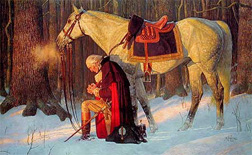
The Fourth of July – the day Americans celebrate their independence and honor the nation’s founding fathers, none more celebrated than George Washington, “Father of the Country.”
This past Thursday, July 2, American artist Arnold Friberg, 96, died. It was Friberg, who created the famous painting of Washington kneeling and praying next to his horse in the snow at Valley Forge. The painting, currently on display at Mount Vernon, has been valued at more than $12 million.
Thomas Jefferson praised Washington as “… the best horseman of his age and the most graceful figure that could be seen on horseback,” and the Marquis de Chastellux noted in his journal that “The General Himself…breaks all his own horses; and he is a very excellent and bold horseman, leaping the highest fences, and going extremely quick.”
John Hunter, an English visitor to Mt. Vernon in 1785, referred to Washington’s stable in a letter to a friend:
“When dinner was over, we visited the General’s stables, saw his magnificent horses, among them “Old Nelson,” now twenty-two years of age, that carried the General almost always during the war. “Blueskin,” another fine old horse, next to him, had that honor. They had heard the roaring of many a cannon in their time. “Blueskin” was not the favorite on account of his not standing fire so well as venerable “Old Nelson.” The General makes no manner of use of them now. He keeps them in a nice stable, where they feed away at their ease for their past services.”
Blueskin, a gray, may have been the son “Lindsey’s Arabian” that Washington acquired as his mount. As the general was over 6 feet 2 inches tall and weighed more than two hundred pounds it is evident that the famous mount must have had some substance.
Following the Revolutionary War, General Washington directed that the services of Lindsey’s Arabian be used extensively on his mares at Mount Vernon. The four famous grey stallions that drew Martha Washington’s coach to Philadelphia, when the first Congress convened, were sons of Lindsey’s Arabian.
Another favorite of Washington’s was Magnolia, a gray Arabian stallion that he raced in Alexandria.
It was also Washington who introduced the mule to American agriculture. Because mules are stronger and easier to maintain than horses, Washington was convinced that they made better draft animals.
Shortly after the Revolutionary War, he received an Andalusian donkey named Royal Gift, as a present from the King of Spain. Royal Gift and a later donkey named Knight of Malta were used to breed mules for work on the plantation. By 1799, there were 57 mules at Mount Vernon, where Washington hoped to eventually “secure a race of extraordinary goodness,” with which to supply the entire nation.
